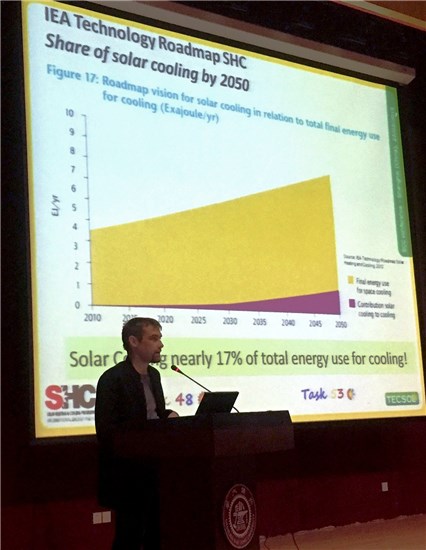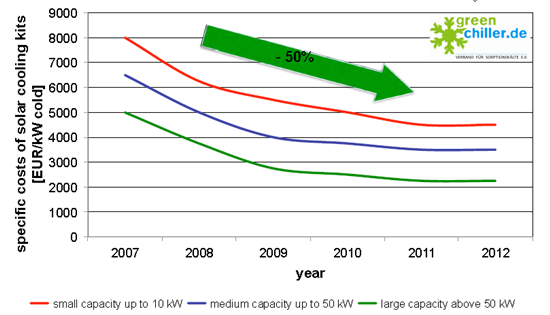Posted: June 16, 2015
 Solar thermal cooling is a “small, but steadily growing market,” Dr Uli Jakob from the Green Chiller Association for Sorption Cooling pointed out in his presentation Solar Air-Conditioning in Europe during the Solar Cooling Week, which took place in Shanghai from 23 to 27 March. The week started with two experts meetings of IEA SHC Task 48 (Quality Assurance and Support Measures for Solar Cooling Systems) and Task 53 (New Generation Solar Cooling and Heating Systems) on solar cooling and ended with the Solar Cooling Conference. About 80 % of the over 100 participants came from Asian countries. Conference Chairman Daniel Mugnier (see photo) thanked “Shanghai Jiao Tong University – and especially, Professor Yajun Dai for having organised “a perfect Solar Cooling Week.”
Solar thermal cooling is a “small, but steadily growing market,” Dr Uli Jakob from the Green Chiller Association for Sorption Cooling pointed out in his presentation Solar Air-Conditioning in Europe during the Solar Cooling Week, which took place in Shanghai from 23 to 27 March. The week started with two experts meetings of IEA SHC Task 48 (Quality Assurance and Support Measures for Solar Cooling Systems) and Task 53 (New Generation Solar Cooling and Heating Systems) on solar cooling and ended with the Solar Cooling Conference. About 80 % of the over 100 participants came from Asian countries. Conference Chairman Daniel Mugnier (see photo) thanked “Shanghai Jiao Tong University – and especially, Professor Yajun Dai for having organised “a perfect Solar Cooling Week.”
Mugnier emphasised the meaning of solar cooling for China. “In China, more than anywhere else in the world, cooling is a massive issue. Air conditioning has gotten a huge boost across the country, especially in the south, while pollution levels have dramatically increased, leading to national mobilisation against it. Hence, any accurate renewable cooling approach is of enormous interest to China,” Mugnier said. According to the IEA’s Technology Roadmap: Solar Heating and Cooling from 2012, the market potential for solar cooling in 2050 will be at an estimated 1.5 EJ per year, with China accounting for about half of it. “Solar cooling is a very promising option for the Chinese authorities and, therefore, it is also very important to researchers,” Mugnier said. Research topics in China include “more or less all fields of solar cooling.” Here, Mugnier listed sorption chillers, PV-driven air conditioning, high-performance solar cooling systems, innovative heat-rejection devices and advanced temperature control solutions. “The research resources dedicated to solar cooling are very important, and the IEA SHC is very proud to get input from China, especially regarding Task 53, which works on the New Generation of Solar Cooling and Heating Systems, and is searching for cost-competitive solutions which can properly address the thrilling challenge of solar cooling in China and the world,” Mugnier said.
Solar cooling market in Europe
Jakob is Member of the Advisory Board of the Solar Cooling Week and estimated that by the end of 2014, more than 1,200 solar thermal cooling systems would be installed worldwide. With about 900 systems, Europe is still the leader in solar cooling, as it is the pioneering region of the lot. But while the “old” market seems to be slowing down, the young Asian one is growing quickly.
The member companies of the Green Chiller Association for Sorption Cooling sold 781 cooling machines until 2013, equalling 21.7 MW of cooling capacity. In 2014, they expected a total of 996 machines equalling 26.3 MW of cooling capacity. Because the association represents 60 % of the European manufacturers of sorption chillers of small and medium sizes (5 to 200 kW), the figures can be seen as an indicator for a growing European market for sorption chillers. The numbers include absorption and adsorption chillers, sold for being combined with solar, waste heat, heating networks and heat from co-generation plants.

Cost Development for Solar Kits in Europe between 2007 and 2012 Source: Green Chiller
Over the past years, prices for solar cooling kits went down in Europe by 45 to 55 %. In 2012, one kW of cooling capacity ranged from EUR 2,200 for a large plant with more than 50 kW to EUR 4,500 for a small system with less than 10 kW of cooling power (see chart above). In 2007, prices ranged from EUR 5,000 to EUR 8,000, depending on the system’s size. The kits consist of solar collectors, mounting systems, storage tanks, pumps, chillers and re-coolers. The main reason why their prices have gone down so much is that collectors of all systems sizes and, in case of small systems, chillers in particular have become more inexpensive – an increasing chiller production has caused prices to fall. “There are more and more standardised solar cooling kits available. They play a major role in reducing costs,” Jakob said. His presentation showed new absorption and adsorption chillers which have made it onto the European market in recent years, from systems by Dutch SolabCool and Austrian Pink to German systems by SorTech, InvenSor, EAW, Fischer Eco Solutions, Baelz, AGO, Tranter Solarice, En-Save, Köhler Industries and SolarNext.
Projects in Germany serve as a showcase for solar cooling technology
“Solar heat is of particular interest as a source of cooling energy if the system is used for other heat requirements as well,” Jakob says. There are two market projects which exemplify this approach: A German project combining solar heating, drinking hot water and cooling, which is currently undergoing field tests and was developed by Solvis, SorTech and the Fraunhofer Institute for Solar Energy Systems, and a second system from Italy, which is under commercial development and was designed by private research centre European Academy of Bozen/Bolzano and Velta Italia, a company specialised in floor heating and cooling systems.
Despite increasingly lower costs, solar cooling applications are still hardly economically viable in Europe without the help of incentive schemes. On 1 April, the government improved conditions for all solar thermal systems, including solar cooling systems, under the German Market Rebate Programme for Renewable Energies, MAP. Now, the scheme pays incentives of 150 to 200 EUR/m2. Applicants owning solar and sorption cooling systems of capacities from 5 to 500 kW have been offered coverage of 25 % of the net investment since January 2014 (http://www.solarthermalworld.org/content/germany-additional-support-small-solar-cooling-systems). “This is great news and will help solar thermal cooling in Germany,” Jakob said. “But nonetheless, Germany’s main role will be to serve as a showcase for the technology. Because of the climate, solar cooling will always remain a niche market here.”
More information:
This text was written by Eva Augsten, a German freelance journalist specialised in renewable energies (augsten(@)solrico.com).